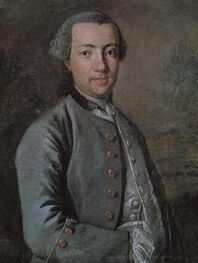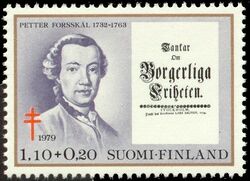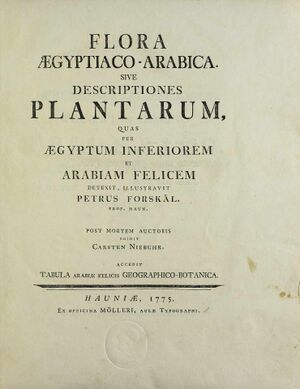پير فورشول
Peter Forsskål | |
|---|---|
 | |
| وُلِدَ | 11 January 1732 |
| توفي | 11 يوليو 1763 (aged 31) |
| القومية | Swedish |
| السيرة العلمية | |
| المجالات | exploration, orientalism and التاريخ الطبيعي |
| Author abbrev. (botany) | Forssk. |
پير فورشول (دنماركية: Pehr Forsskål؛ عاش 11 يناير 1732 - 11 يوليو 1763) كان عالم أحياء ومستشرقًا ومستكشفًا سويدي، ولد في 11 يناير 1732 بهلسنكي (كانت وقتئذ تابعة للسويد، وهي عاصمة فنلندا حاليًا).
حواري لينايوس
في جامعة اوپسالا، أصبح من حواريي كارولوس لينايوس في دراسة العلوم. كما درس الفلسفة واللغات العربية والفارسية والتركية على يدي كارل أوريڤيليوس، الذي كان على صلة بالمستشرق الألماني يوهان دافيد ميخائليس Michaelis في گوتنگن، ولعل ذلك كان السبب في سفر فورسكول لمواصلة الدراسة في جامعة گوتنگن. شارك كارستن نيبور Carsten Niebuhr في رحلته عام 1761. له ابحاث ومصنفات عن الحيوان والنبات في غرب وجنوب غرب آسيا. زار تركيا وسوريا وفلسطين ومصر واليمن.
الرحلة إلى اليمن والوفاة
On Michaelis's recommendation, and with Linnaeus's approval, Forsskål the next year (1760) was appointed by Frederick V of Denmark to join, amongst others, the orientalist and mathematician Carsten Niebuhr on an expedition to Arabia. The group first went to Egypt where they stayed for about a year, with Forsskål pursuing studies in Arabic dialects, and arrived in South Arabia (Arabia Felix, present-day Yemen) at the end of December 1762. Just 31 years old, Forsskål worked hard on collecting botanical and zoological specimens, but fell ill with malaria and died in July 1763. He was buried at night in Yarim, Yemen.[1]
توفي يوم الاثنين 11 يوليو 1763 في اليمن، مريضاً، ودفن هناك.
Linnaeus mourned the death of his young student and named one of the plants Forsskål had sent home Forsskaolea tenacissima because the plant was as stubborn and persistent as the young man had been.
The entire journey of this Danish expedition was the subject of Thorkild Hansen's first book, Det lykkelige Arabien (1962, translated into English as Arabia Felix).
ذكراه
Forsskål's companion Niebuhr, who was the only one of the participants to survive the expedition, was entrusted with the care of editing his manuscripts, and published in 1775 Descriptiones Animalium – Avium, amphiborum, insectorum, vermium quæ in itinere orientali observavit Petrus Forskål. In the same year his account of the plants of Yemen and of lower Egypt also appeared, under the title of Flora Ægyptiaco-Arabica sive descriptiones plantarum quas per Ægyptum Inferiorem et Arabiam felicem detexit, illustravit Petrus Forskål. Most of his specimens were lost in transport or deteriorated due to bad storage in Copenhagen; his herbarium was reconstructed some 150 years after his death by the botanist Carl Christensen.
In his taxonomy work, Forsskål used the local Arabic name of the fish as the species name:[2] these reflect the names used then (and now) on the coasts of the Red Sea for many species of fish.
In his pamphlet, Thoughts on Civil Liberty (1759), Forsskål argues the case for civil liberties of the kind people in modern democracies take for granted. A sample (para 21):
Finally, another important right in any free society is the liberty to contribute to the Public Good. But for this to happen, it must be possible to make the state of affairs in society known to one and all, and everyone must be free to express their thoughts about it. Where this is lacking, liberty is not worth its name.
Shortly after its publication the pamphlet was banned, and Forsskål was forced into exile. But only seven years later, in 1766, freedom of the press was given protection in Swedish constitutional law -- the first such legislation in world history. (Under the reign of Gustaf III Sweden fell back into repression. Freedom of the press was reinstated in the Constitution of 1809.)
أنواع مسماة تكريماً له
The Tiger fish Hydrocynus forskahlii was named in his honor by Georges Cuvier. Forsskaal originally reported this species as Salmo (=Alestes) dentex in 1775.[3]
منشوراته
نشر كارستن نيبور أبحاث فورسكال عام 1775 بعنوان: "شروحات مصورة عن حيوانات وطيور وزواحف وحشرات ونباتات تعيش في غرب آسيا".
أصدر كتابًا آخر عن نباتات اليمن وجنوب مصر. كان يبعث أثناء الرحلة رسائل يخبر لينايوس نتائج مشاهداته وأبحاثه. نشرت المراسلات.[4]
- Thoughts on Civil Liberty / Tankar om borgerliga friheten (1759). Stockholm: Bokförlaget Atlantis, 2009. ISBN 978-91-7353-360-7. [Edited and translated by David Goldberg, Gunilla Jonsson, Helena Jäderblom, Gunnar Persson and Thomas von Vegesack, assisted by David Shaw.] (Swedish Wikisource)
- * Flora Aegyptiaco-Arabica (in اللاتينية). København: Nicolaus Möller. 1775.
- * Descriptiones animalium (in اللاتينية). København: Nicolaus Möller. 1775.
- * Icones rerum naturalium (in اللاتينية). København: Nicolaus Möller. 1776.
- Resa till lyklige Arabien. 1950.
المراجع
- ^ Cactus and Succulent Journal (in الإنجليزية). 2004.
- ^ Baheyeldin, Khalid. "Forsskål's use of Arabic names for fish species". baheyeldin.com. Retrieved 8 May 2019.
- ^ "The ETYFish Project: Order Characiformes: Families Distichodontidae, Citharinidae, Crenuchidae, Alestidae and Hepsetidae". The ETYFish Project. Christopher Scharpf and Kenneth J. Lazara. 2016-08-09. Retrieved 29 September 2021.
- ^ منتدى الحديقة. أسماء أشجار ونباتات الغابات. تاريخ الولوج 28 حزيران 2011.
وصلات خارجية
- Book Flora Aegyptiaco-Arabica, by Peter Forskål, year 1775, in Latin.
- Book Descriptiones animalium ... quæ in itinere orientali, by Peter Forskål, year 1775, in Latin.
- Book Icones rerum naturalium quas in itinere orientali, by Peter Forskål, year 1776, in Latin.
- Biography of Forsskål with links to other web sites on him, and includes how he used Arabic names for species names.
- Peter Forsskål, Royal Library, Copenhagen, Oriental collections - mainly on Forsskål's contributions to the knowledge of Arabian pharmacognosy
- Thoughts on Civil Liberty English, French, German, Swedish and Spanish translations of Forsskal's original (uncensored) manuscript.
 Chisholm, Hugh, ed. (1911). . دائرة المعارف البريطانية (eleventh ed.). Cambridge University Press.
Chisholm, Hugh, ed. (1911). . دائرة المعارف البريطانية (eleventh ed.). Cambridge University Press. {{cite encyclopedia}}: Cite has empty unknown parameter:|coauthors=(help)
- Articles containing دنماركية-language text
- Pages using Lang-xx templates
- CS1 اللاتينية-language sources (la)
- مقالات المعرفة المحتوية على معلومات من دائرة المعارف البريطانية طبعة 1911
- علماء نبات ذوي مختصرات اسمية
- مواليد 1732
- وفيات 1763
- أشخاص من هلسنكي
- خريجو جامعة أوپسالا
- خريجو جامعة گوتنگن
- مستكشفون سويديون
- مستكشفون فنلنديون
- Finnish naturalists
- Swedish naturalists
- Swedish taxonomists
- علماء نبات فنلنديون
- علماء نبات سويديون
- Finnish zoologists
- Swedish zoologists
- Swedish phycologists
- Pteridologists
- مستشرقون سويديون
- مستشرقون فنلنديون
- Botanists active in Egypt
- Botanists with author abbreviations
- Age of Liberty people
- 18th-century Finnish people
- 18th-century Swedish scientists
- 18th-century botanists
- 18th-century explorers
- 18th-century zoologists
- Deaths from malaria
- علماء أحياء


